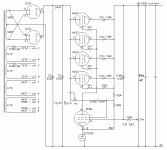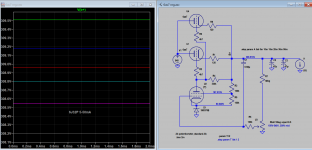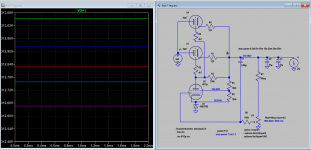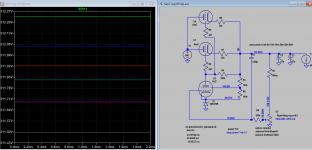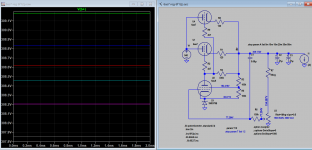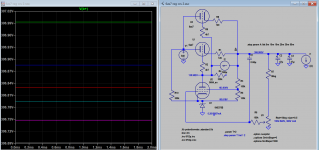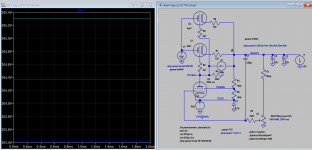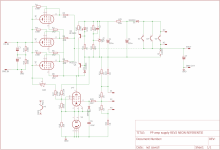I would like to scale down the regulated power supply used in Thorsten Loesch's Legacy 300B amp to use it with a 6V6 preamp that I would like to build. Please see the attached original power supply schematic. My thoughts are to use only one each of the rectifier and 6AS7 tube, which should be relatively straightforward, but I would also like to use something other than a EF86, as I would rather use them in more audio specific application. Any other common 9 or 7 pin tube will do. A suitable replacement for the ZZ1000 reference would also be helpful. I will be using a lower voltage power transformer. I have designed and built many linear supplies, but regulated supplies of this sort are new to me. Any suggestions as to suitable tubes to replace the EF86 and the ZZ1000, as well as required component changes, and any advice as to things I should look out for would be much appreciated.
Attachments
Last edited:
You can replace EF86 with 6J32P, 6Zh32P (Russian: 6Ж32П.), ZZ1000 with 80V zener diode. May need to change the trimmer value as number of tube tubes used are different.
Attachments
you could use a single 6080 instead of two. And a EF80 or EF184 CCS loaded error amp. CCS loading a EF184 is bound to give better performance than a resistor loaded EF86
For the reference the 85A2 is hard to beat noise and stability wise.
I have a board for a supply with 2X 6080. And one with 3x EL34 or 6L6 or E235L
PM me if you want me to send you schematics of the boards ive made. Or redesign a board for your use.
For the reference the 85A2 is hard to beat noise and stability wise.
I have a board for a supply with 2X 6080. And one with 3x EL34 or 6L6 or E235L
PM me if you want me to send you schematics of the boards ive made. Or redesign a board for your use.
Thanks for the reply and the schematics. Unfortunately, I don't have any of those tubes on hand. I have 6EJ7, 6AU6, and many other North American pentodes, but all my Russian tubes are either dual triodes or pentode power tubes.You can replace EF86 with 6J32P, 6Zh32P (Russian: 6Ж32П.), ZZ1000 with 80V zener diode. May need to change the trimmer value as number of tube tubes used are different.
Thank you very much for the schematics. I also have many, many 5654 tubes. How would they fit into the circuit? Also, is there any reason to use an EF86 in this position instead of the other tubes you made circuits for?They're both working in this circuit. As for triode section, it could be used as CCS for pentode as suggested in post #2
5654 also works. Any tube with decent gain can work. Gain control the regulation (%) and low noise tube (like EF86) is prefered.
Some nice ideas there. 6EJ7 my favorite made a good LPT driver with 2 of these and 10.7MHz IF strip/FM detector with 4. Prettier than a 6AU6 and more abrupt.
Thanks again. Being unfamiliar with regulated power supplies, I assumed that the surrounding component values would need to change in the circuit when the tube is changed. It seems that isn’t the case, which is great as it opens up many possibilities. I guess any voltage reference of about 80 volts would also work in the circuit?5654 also works. Any tube with decent gain can work. Gain control the regulation (%) and low noise tube (like EF86) is prefered.
Yes, in fact a resistor on the cathode that output 80V will work, but this voltage will vary so better to use zener to stabilize the output. The input to the control tube must be able to provide a -ve bias say -1v=79v-80v, this varying input in turn varied the plate voltage which is also regulated voltage. So trimmer with voltage divider should design to provide the required input. The regulated output be not exactly equal if different tube is used, due to different bias operting point and gain. Maybe some tubes will be higher and become unstable, need grid stopper install for instance. As in sim, you're right, it seems the surrounding components should work when tube is changed.
The zener has a temperature voltage change of around 100mV/deg C. So that will be dominant in the output voltage. So as the unit warms up the output voltage may change by up to 20V. A couple of TL431 shunt regulators in series would get you to 70V with better stability.
Last edited:
Thanks. What would you use as the CCS? Using the ZZ1000 seems simpler and cleaner than a Zener, if pricier. Also, a VR tube is similarly simple and will look nice too. I have a bunch of VR tubes on hand. I need to check to see if any operate at around 80 volts.Here are the improvement that I believe would increase voltage regulation to 0.2%, maybe even more tolerant to tube changes:
1) Increase zener diode current
2) Use CCS instead of plate resistor.
Thanks. I’ll look into the TL430 as well.The zener has a temperature voltage change of around 100mV/deg C. So that will be dominant in the output voltage. So as the unit warms up the output voltage may change by up to 20V. A couple of TL431 shunt regulators in series would get you to 70V with better stability.
CCS for the anode/plate, a gyrator or something, not to confuse with one in cathode.Thanks. What would you use as the CCS? Using the ZZ1000 seems simpler and cleaner than a Zener, if pricier. Also, a VR tube is similarly simple and will look nice too. I have a bunch of VR tubes on hand. I need to check to see if any operate at around 80 volts.
Here is a sim for showing output variation when temp. varied by +-2.5 degs. for reference only. If you have ZZ1000 then use it in the cathode.
Attachments
No point in doing so, 85A2 is amazingly stable and low noise. its temperature coefficient is -2.7mV/K which is ~32PPM @ 85V which is better than a most zener diodes. At this point the output divider resistors and tube ageing will affect output voltage more.Good idea, or design a temperature compensation schematic for 80v zener.
Furthermore its long term stability is 0.01% if operated at 3..3.5mA you can bypass the CCS and G2 divider current with a 12K resistor.
See Pic attached for the schematic of the 3x EL34 supply, its amazingly stable and low noise. It uses a TL431 to furnish a +5V reference with respects to output(Derived from the pass tube heaters), A PNP (BC327)+Led sets the anode current of the EF184 and the MJE350 sees the grid-cathode voltage of the pass tubes.
You can make the supply immune to tube ageing by calculating the divider ratio for G2 of the EF184.
Attachments
This schematic looks great. My intended application is in a 6V6 preamp. Would it be scalable to reflect this use? The preamp has relatively low B+ requirements, and this power supply would use three EL34s to provide power to two 6V6s. It seems that it would be great for a powerful PP amp, but a scaled down version might be better for my use. Also, with respect to voltage variations caused by the thermal drift of zeners, what would be the practical impact with respect to sonics of this drift for a 6V6 preamp? Assuming that the B+ doesn’t reach the maximum allowable dissipation for the tube in this circuit, will a slow rise in B+ over time adversely affect sonics? My understanding of the benefits of tube regulated supplies for single ended circuits is that the benefits are with providing a low impedance power supply for the circuit more than with a constant voltage over time. Again, I’m a noob with respect to regulated supplies, so please correct me if I’m wrong.No point in doing so, 85A2 is amazingly stable and low noise. its temperature coefficient is -2.7mV/K which is ~32PPM @ 85V which is better than a most zener diodes. At this point the output divider resistors and tube ageing will affect output voltage more.
Furthermore its long term stability is 0.01% if operated at 3..3.5mA you can bypass the CCS and G2 divider current with a 12K resistor.
See Pic attached for the schematic of the 3x EL34 supply, its amazingly stable and low noise. It uses a TL431 to furnish a +5V reference with respects to output(Derived from the pass tube heaters), A PNP (BC327)+Led sets the anode current of the EF184 and the MJE350 sees the grid-cathode voltage of the pass tubes.
You can make the supply immune to tube ageing by calculating the divider ratio for G2 of the EF184.
Thanks. Yes, CCS on the anode. Will any CCS do? Also, does your sim show the ZZ1000 as reference? My preference would be to have the supply be all tube and as simple as possible. Loesch’s supply seems overkill for my application, and I would prefer to not use EF86 because it seems a bit wasted in this use. It also seems that the ZZ1000 is a good option because of its performance and stability as compared to zeners. Wouldn’t VR tubes be similarly stable and simple to implement, without being sonically inferior?CCS for the anode/plate, a gyrator or something, not to confuse with one in cathode.
Here is a sim for showing output variation when temp. varied by +-2.5 degs. for reference only. If you have ZZ1000 then use it in the cathode.
- Home
- Amplifiers
- Tubes / Valves
- Loesch Legacy 300B power supply mod for preamp
